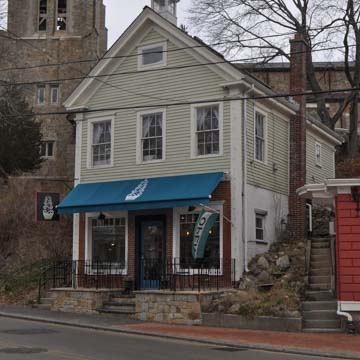The history of the American fire station dates to the nineteenth century, and Cohasset’s Independence Fire Engine Company Station, the town’s first, offers a representative example of this building typology. However, this particular station, built circa 1848 in the Greek Revival style, also strongly represents an adaptive use tradition in New England towns that reflects both an ethic of thrift as well as a community’s adjustments to growth and social change. The small fire station represents a combination of municipal and private interests adapting an unusual, purpose-built structure for six other uses since its construction.
Independence Fire Engine Company Station fits squarely within the development of a nationwide building tradition. Fire stations emerged as a new typology in the nineteenth century and reflected the growing sense that what was once a community obligation and later undertaken by private groups should be conducted by a volunteer fire company as a duty within a democratic society. Only after the Civil War did municipal governments take control of fire service. Thus, in the antebellum period, stations like Cohasset’s operated somewhat like a fraternal lodge or headquarters for an important volunteer civic organization. It is unsurprising, then, that the builders of the Independence Fire Engine Company Station chose the Greek Revival style for their building. This selection reflected more than fashion, instead it evoked the heritage of democracy and the promise of a modern government that rested upon civil society. The volunteer fire company provided order and safety to the community, and the Greek Revival style most effectively embodied this combination of attributes.
The Cohasset station is a two-and-a-half-story rectangular building set flush with the town’s main commercial street and into a steep slope. The brick ground floor, perhaps meant to signal it was a civic building, originally featured a wide central bay topped by a brownstone lintel (still evident today). This entrance, once flanked by singular double-hung windows, allowed passage of the first “hand tub pumper” named Independence. The wooden upper stories, sheathed in clapboard, include a second floor that provided a meeting space (named Engine Hall) for the firefighters and an attic that contained a reel for hose storage. Characteristic of the Greek Revival, the structure’s gable-end facade features pilastered cornerboards with cornice returns that suggest a pediment, but in a departure from the style, the roof ridge featured a center cupola housing a fire alarm bell.
For 65 years the Independence Fire Engine Company Station, built by the town but operated by the volunteer Independence Fire Company, served in its original capacity and retained its original look. In 1913, however, Cohasset opened a new fire station in the town’s harbor area and converted this building to another civic use: the town’s first police station. Attendant with this, the large front door was reduced and two small jail cells with barred doors were added in the rear portion of the ground floor.
In 1960, the building underwent another change when Cohasset built a new police and fire headquarters elsewhere in town. In 1963, the town leased the building to the Cohasset Historical Society for use as a museum. Twenty years later the museum shuttered and the building reverted to the town’s Selectmen for consideration. In 1986, they decided to lease the building, and in 1988, a local attorney rented it for use as an office until the early 1990s. At that point, the town repurposed the building as the Teen Center, an activity center for Cohasset’s teenage youth, but by mid-decade the Teen Center had vacated the premises and the town officially declared the building surplus. Cohasset put the building up for sale at public auction and a local businessman converted it to a residential apartment building in 1999. During this renovation, the building received a new, smaller cupola. The apartment has served variously as a rental property and single family dwelling until 2014 when it became a boutique bakery. To enact this transition, the current owner inserted large picture windows in its facade to showcase the baked goods for sale. This building, constructed to fulfill an important public service, has proved its adaptability the century and a half since its construction.
References
Norfolk County Registry of Deeds, Dedham, Massachusetts.
Wadsworth, David H. “Form B – Building: 24 South Main Street, ‘Independence,’ Cohasset, MA (COH.108).” Boston: Massachusetts Historical Commission, April 1980, revised June 1988.
Zurier, Rebecca. The American Firehouse: An Architectural and Social History.New York: Abbeville Press, 1982.











